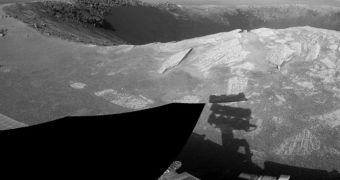The Mars Exploration Rover (MER) Opportunity will be spending New Year's Eve at a large crater on the Red Planet, called Santa Maria. The football-field-size landscape feature was most likely generated millions of years ago, when a small asteroid impacted the surface.
The rover made its way to Santa Maria on December 16, and parked on its southeastern rim. During the holidays, it will be conducting analysis of the sediments and other rocks at the location, in a bid to better understand Martian geology.
Studying craters is the best way of doing this because the impacts pierce through the upper layers of the planetary crust, revealing the layers underneath. Studying how their disposition changes from one area to the other allows experts to develop models to explain what happened.
In the process, they may also gain additional information about how the planet looked like in its distant past, when geologists and planetary scientists believe a huge ocean of liquid water covered a large swath of Mars' northern hemisphere.
The 295-foot (90-meter) wide Santa Maria is a medium-sized crater, but it too could provide more insight into the planet's past, at least until Opportunity manages to reach Endeavor, a massive crater that is its ultimate destination.
Since 2008, when it first turned its attention on the crater, the rover has driven more than 9 miles (14.5 kilometers), stopping from time to time for a few weeks or so, to analyze interesting objects along the way. It has seen several small craters, as well as a number of meteorites on the surface.
The rover has made tremendous progress over the past 2 years. Already nearly 7 years old, it has about 3.7 miles (6 kilometers) to go before it reaches the 14-mile (22-kilometer) wide Endeavor.
This is the largest crater that is within reach, and scientists at the NASA Jet Propulsion Laboratory (JPL), in Pasadena, California, who manage the MER mission, hope to reach it in 2011.
Until then, they are settled with studying Santa Maria, which is special in its own rite. According to preliminary analysis, it is very, very young, most likely only a few million years old, Space reports.
The main implication of this is that its edges have not yet faded away, which makes observations easier to conduct. “We've never seen a crater this fresh, this big,” explains Washington University in St. Louis expert and MER deputy principal investigator Ray Arvidson.

 14 DAY TRIAL //
14 DAY TRIAL //